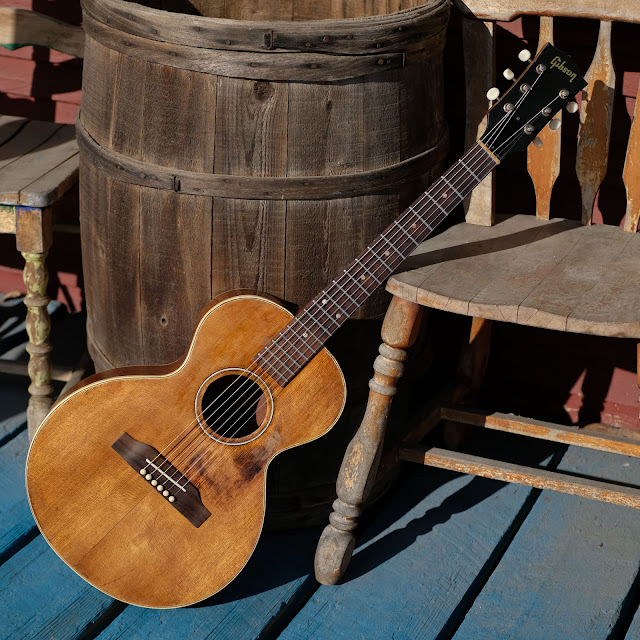1965 Gibson B-25 3/4 Flattop "Terz" Guitar
A consignor of mine owns this and when he called me on the phone a while back and told me he'd snagged an LG-2 3/4, I was a bit interested as I've never played one. They're not exactly everywhere and the sky-high prices for them have always perplexed me in the same way Martin 5-18s seem to be hot-to-trot in the vintage market.
When he walked-in with it, however, I had a small chuckle in my brain. This poor thing was in "quite a state." The neck block/side/back seam was entirely open and riddled with lots of gobbled old glue, the fretboard was half-falling off, the bridge was replaced, and it turns-out it's a mid-'60s B-25 3/4 rather than a '50s LG-2 3/4. They're "the same guitar" in many ways, but '60s instruments are often voiced a lot differently from '50 ones. Oh -- and it'd also been entirely refinished except for the headstock. How about that?
Work included fixing the bad seam mucking-up at the neck block (hopefully it's now good to go), a brace repair/reglue to the upper bout, brace reglue on the back, crack repairs on the back, regluing of the fretboard, a heavy-handed fret level/dress to deal with the funky board and fret inconsistencies, a mild bridge shave and saddle-slot fill and relocation (they glued it 1/8" too far to the rear), cleaning, a new bone saddle, and setup. Remarkably, it's playing perfectly with 3/32" EA and 1/16" DGBE action at the 12th fret. I have it strung with 54w-12 strings for "normal" E-to-E tuning, but with 46w-10 strings this would easily tune-up G-to-G above that and have a nice, terz guitar shimmer and sparkle to the sound. This one has a 22 3/4" scale length.
What's it sound like, though? To be honest, it sounds like a diminutive Kalamazoo KG-14 with maybe a little less pop and a little more ka-chunk in the mids and lows. This isn't too surprising as the body is quite curvy, the bridge is pretty far forward, and it features ladder bracing along Kalamazoo-guitar lines on the top. I like it a lot for fingerpicking.
Old "repairs" are abundant on this instrument, however. Aside from the tacky refinishing job, the remains of the original pickguard were too abused to re-use (I think it's better without it, anyway), there are random glue-trails here and there on the inside, and someone installed an extra, bigger bridge plate to the rear of the original one. This might have something to do with the fact that someone converted this from the original adjustable-saddle bridge (the post-insert holes are still extant on the underside) to this "normal" slotted-saddle bridge.
Even if it's a bit beat-up, I kinda like the looks of this in a "faded champ" sort-of way.
The truss works and the cover is still extant. The tuners might be replacements but are Kluson-style and the original 1 5/8" plastic nut is still going strong.
The board is rosewood and the frets are pretty shallow height-wise but still have some life left in them.
The funky replacement bridge shaped-up nicely. Note that the saddle-slot has been relocated forward.
The saddle also has some string-ramps behind it and good, ~1/8" height for future action adjustments.
Just like the "big" B-25, the 3/4 has mahogany back, sides, and neck.
While some might think of the screw-on Gibson strap buttons as a little more "lame" than a friction-set endpin, I think they're actually a lot safer. It's a lot harder to split your endblock and sides by dropping the guitar on one of these than it is with a tapered, wedge-of-doom endpin.

















Comments